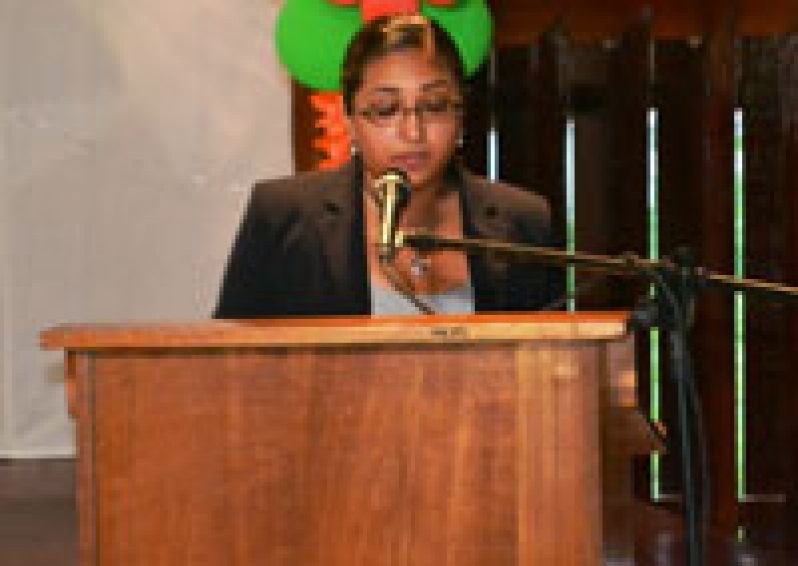THE issues and struggles which faced East Indian migrant women were the focus of the third of a three- part lecture series organised by the Ministry of Culture, Youth and Sport to mark the 175th anniversary of East Indian arrival to Guyana. The lecture, titled “Her Middle passage: Indian Women and the Journey of Indentureship” was presented by Guyanese-born author, Gaiutra Bahadur.
 Referring to what has been described as “the tyranny of the text”, Ms Bahadur said that given a lack of historical accounts from migrant indentured women, there is a gap in archival materials. She said that she garnered her information, from ships’ logs, diaries of ships’ owners, traders and old newspaper reports, which only gave part of the history which needed to be told. She also travelled to India and Guyana where she met distant relatives to obtain research material for her forthcoming book, “Coolie Woman”. It traces the journey of her great-grandmother from Calcutta to the Caribbean as an indentured servant, or “coolie,” on a British sugar plantation. In the process, it
Referring to what has been described as “the tyranny of the text”, Ms Bahadur said that given a lack of historical accounts from migrant indentured women, there is a gap in archival materials. She said that she garnered her information, from ships’ logs, diaries of ships’ owners, traders and old newspaper reports, which only gave part of the history which needed to be told. She also travelled to India and Guyana where she met distant relatives to obtain research material for her forthcoming book, “Coolie Woman”. It traces the journey of her great-grandmother from Calcutta to the Caribbean as an indentured servant, or “coolie,” on a British sugar plantation. In the process, it  also unearths the largely forgotten history, according to Ms Bahadur, of a quarter of a million other women who left India in similar fashion.
also unearths the largely forgotten history, according to Ms Bahadur, of a quarter of a million other women who left India in similar fashion.
She recounted some of the experiences by several migrant women, described as the scarce sex since they came in a ratio of 100 men to 40 women.
She noted that the journey opened up new boundaries for them, and that due to a shortage of women, many were able to pick their partners, as against what was traditional in India. Many of the indentured women selected their partners from the ranks of those who could assist them in various ways, such as drivers, overseers, or men who were veteran residents in the colonies.
The issue of domestic violence within the community, the author opined, may have had much of its genesis in the fact that many of the men who were rejected reacted with extreme violence in many cases. She said that, “from 1859 to 1917, 167 women were killed by men who were rejected in some form or the other”. This trend, she noted sadly, continues today, but the difference is that in decades past, many of those who attacked or murdered women were caught and punished, or committed suicide. Many of those who perpetrate violence against women, at present, are literally getting away with murder, so to speak, as many go unpunished and even those who are victims are not confident that justice would be served.
She expressed the hope that the stories of those who suffered would inspire their modern counterparts, and lamented that the homicide rate for Guyanese women at the hands of their partners was four times that of the United States and three times that of the United Kingdom.
She read a passage of her forthcoming book, which highlighted the plight of several of the indentured women who travelled the 10,500 nautical miles from Calcutta to Guyana, in search of a new life. Their backgrounds and circumstances forced many of them to leave their homeland and the only life they had ever known forever.
The author’s freelance reporting, criticisms and essays have appeared in The New York Times Book Review, The Virginia Quarterly Review, The Washington Post, The (London) Observer, The Nation, Ms. Magazine, Global Post and The National (Abu Dhabi), among other publications. She has worked as a staff writer for daily newspapers in the U.S. for a decade, primarily at the Philadelphia Inquirer. The author has also reported from Iraq, Syria, the United Kingdom, Jordan, Guyana and Canada. She is conversant in Spanish, French, Parachute Arabic, Hinglish (a mix of English and Hindi), and Guyanese Creole.
Her first book was published in 2012, titled ‘Family Ties’. Her next book, ‘Coolie Woman’, will be published by the University of Chicago Press in the U.S. in October, Hurst & Co. in the U.K. in July, and Hachette in India in late 2013.
Previous lectures were conducted by Professor Dr. Brinsley Samaroo under the theme ‘Making a Difference: The East Indian presence in the Caribbean, 1838-2013’ and Dr Kusha Haraksingh on “A Far Horizon, a World Made Small”.



.jpg)









